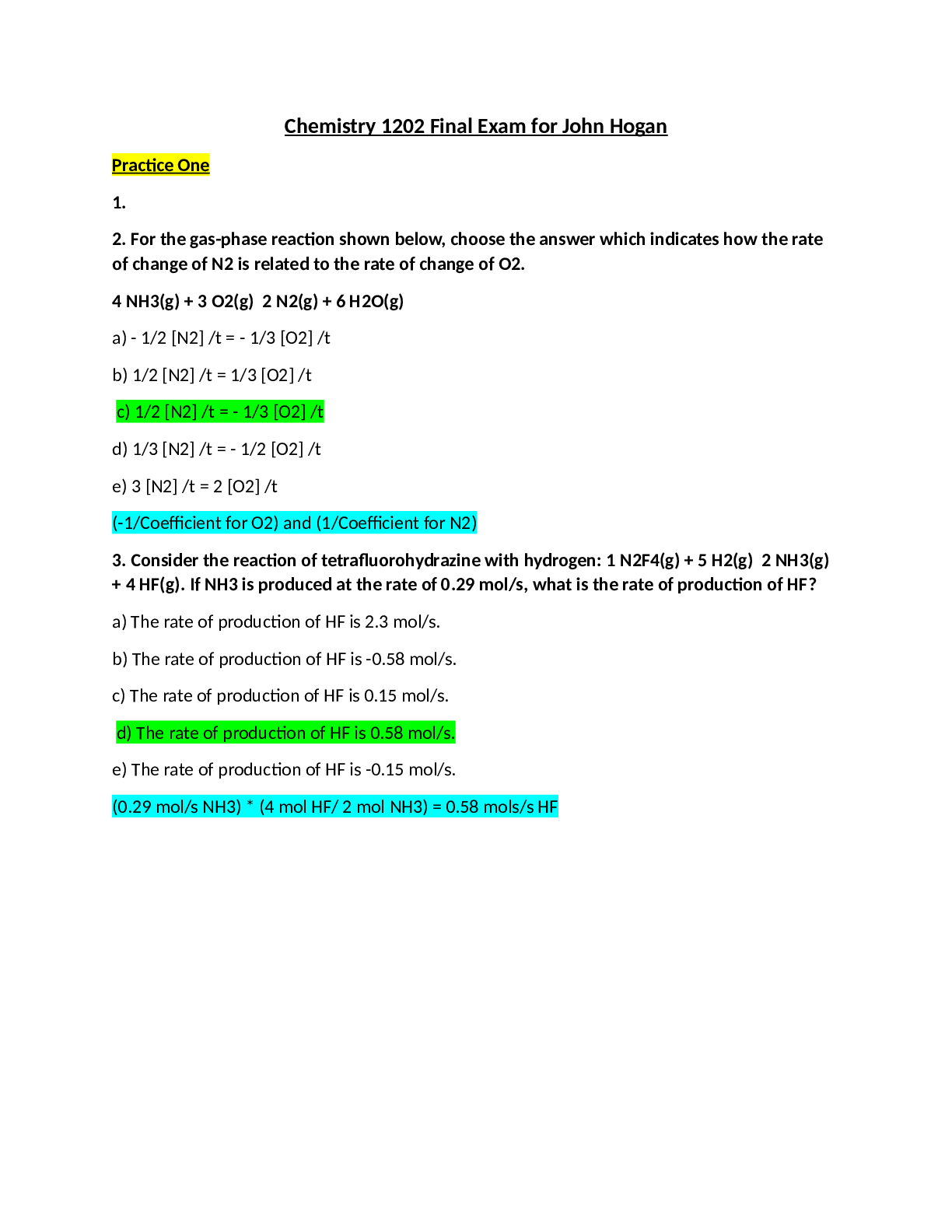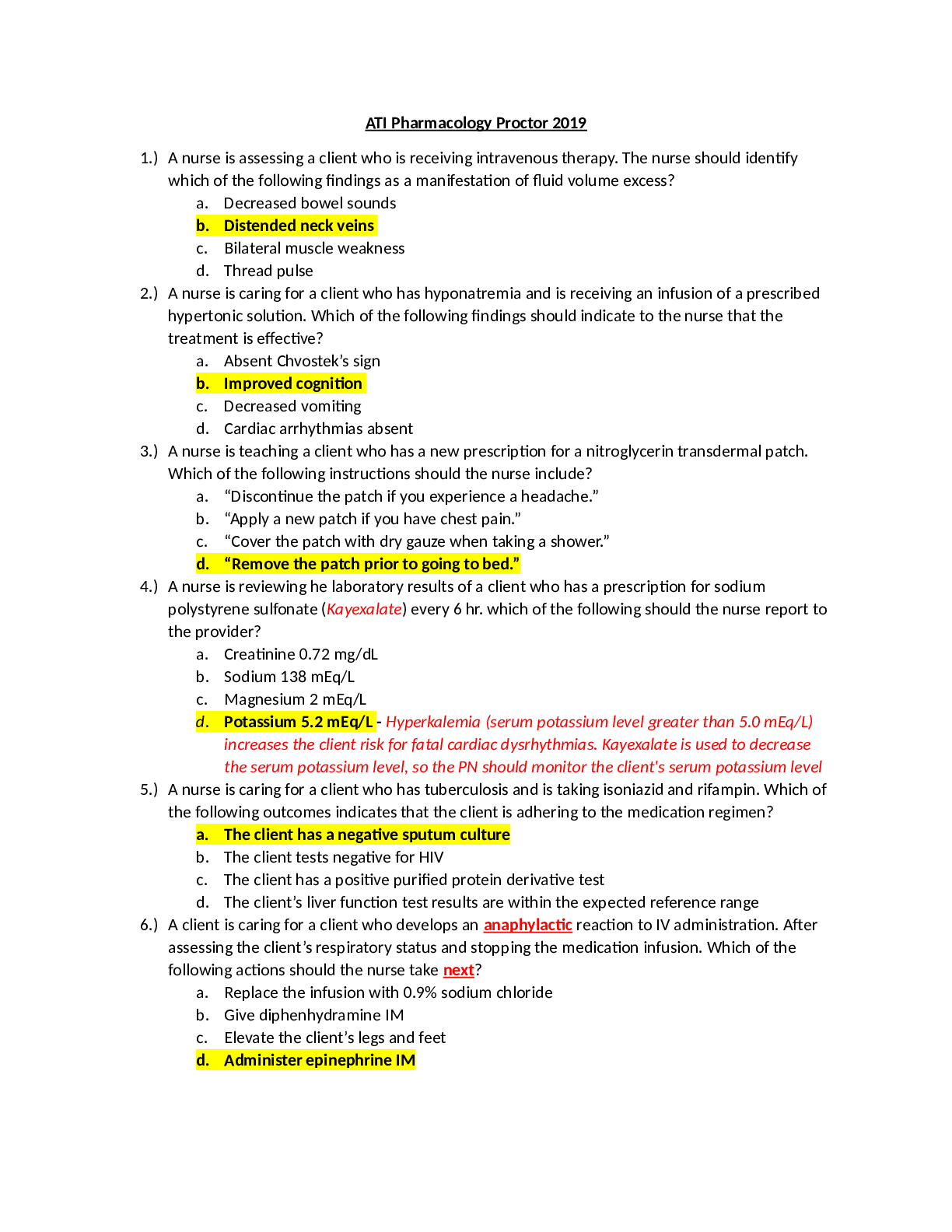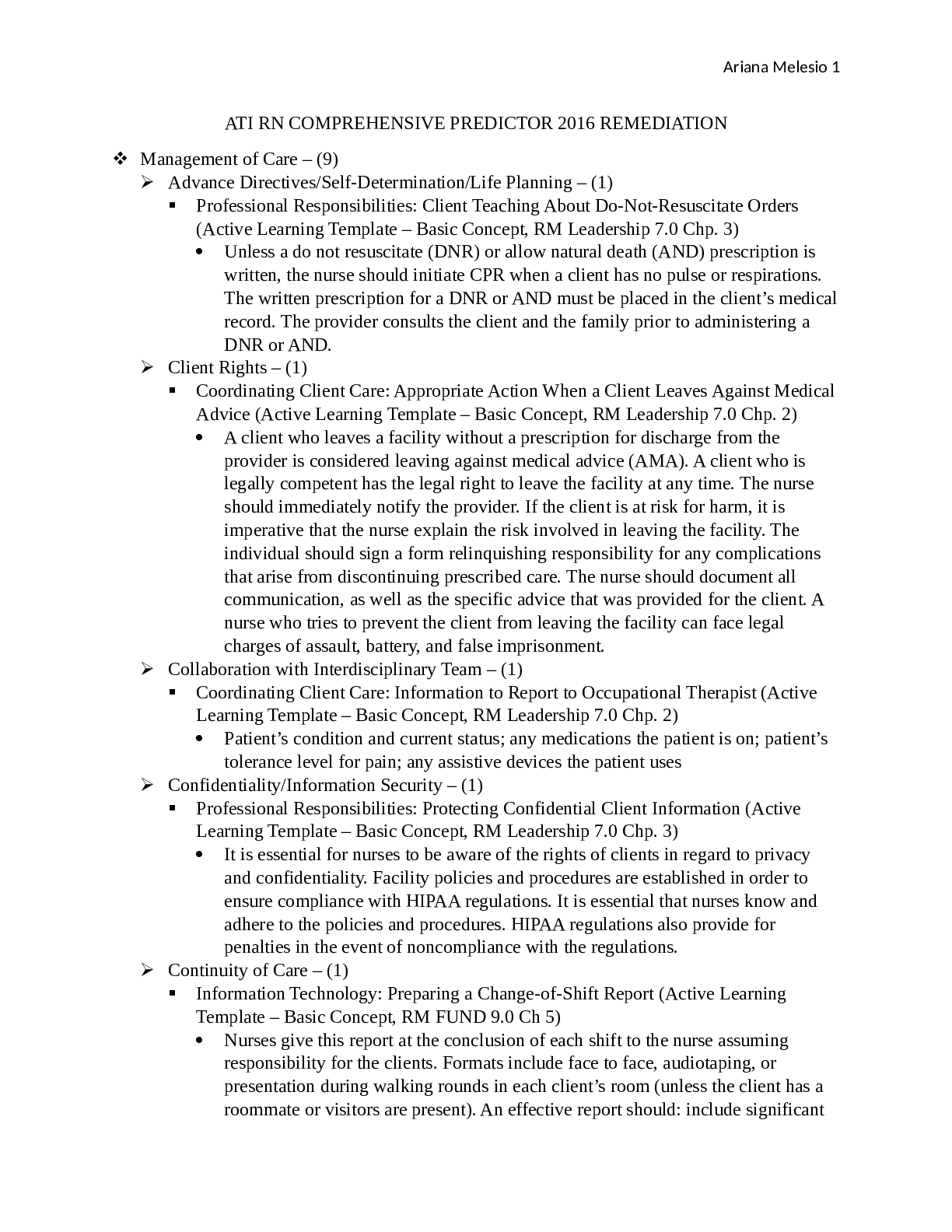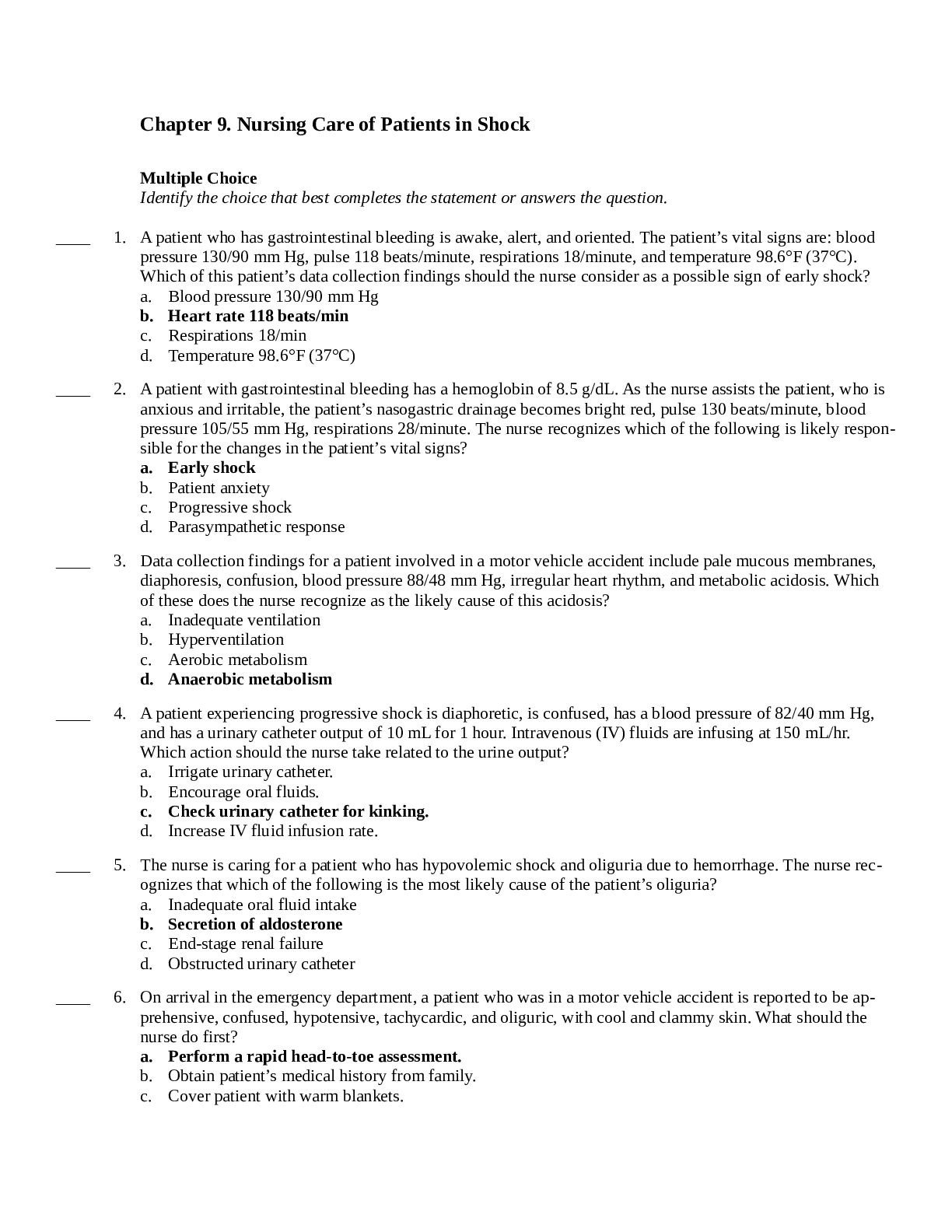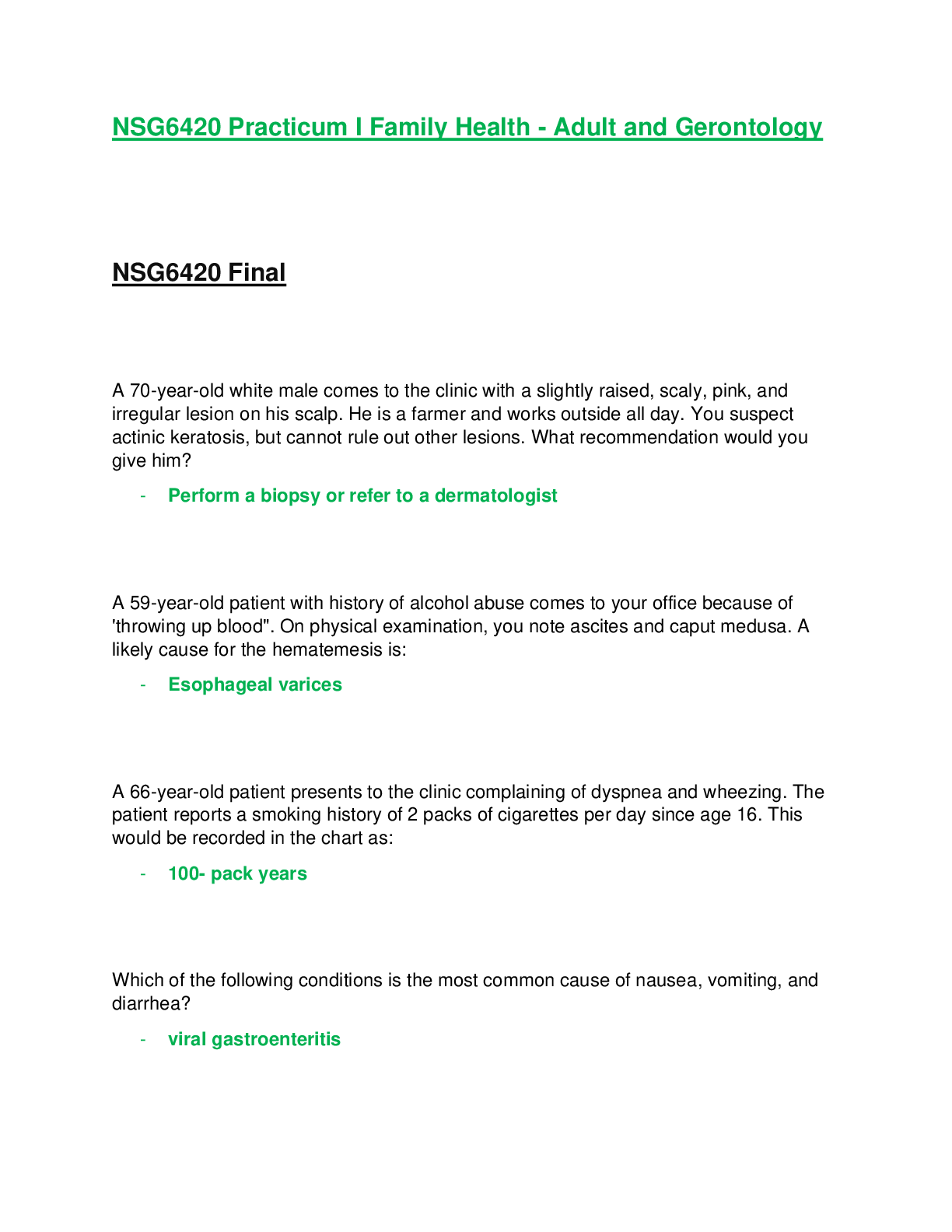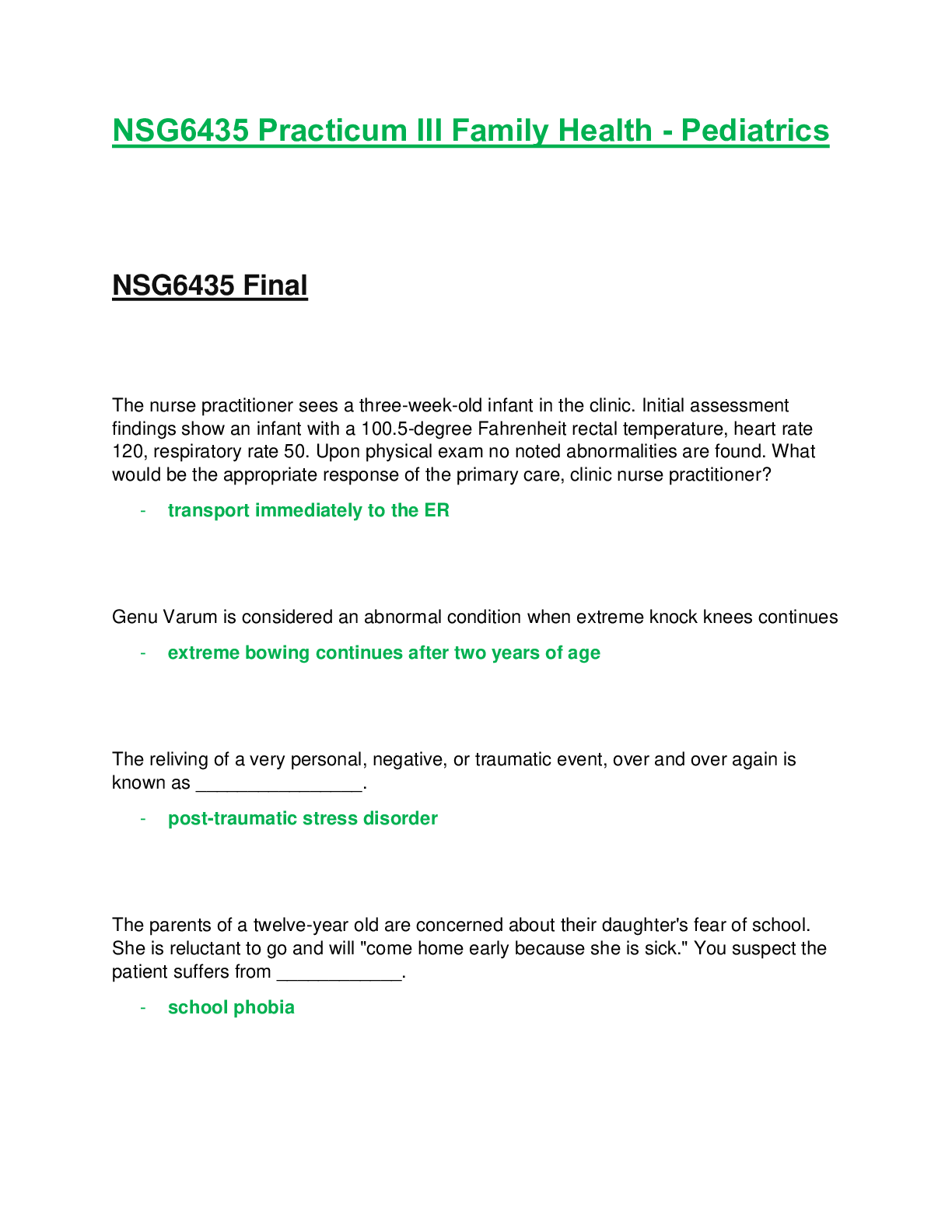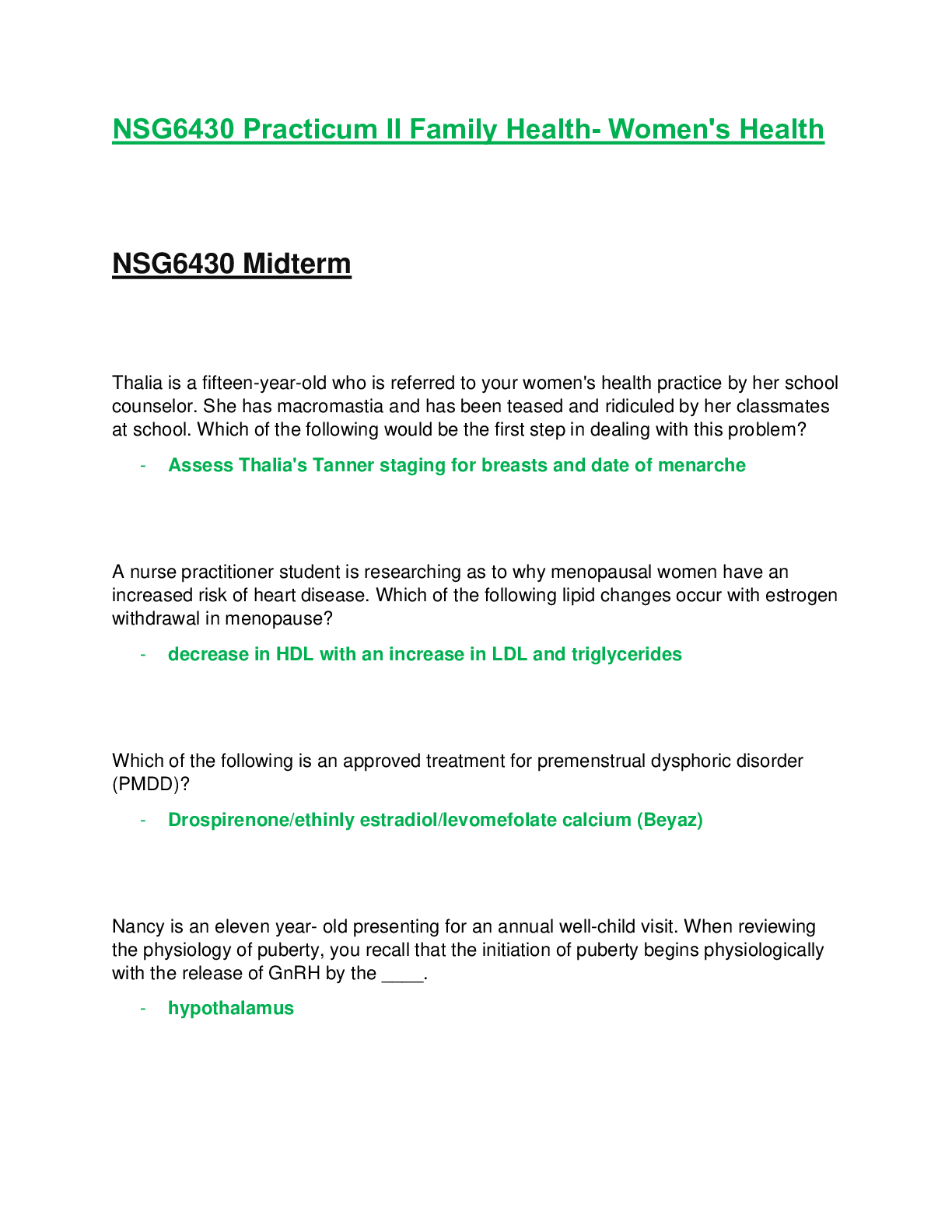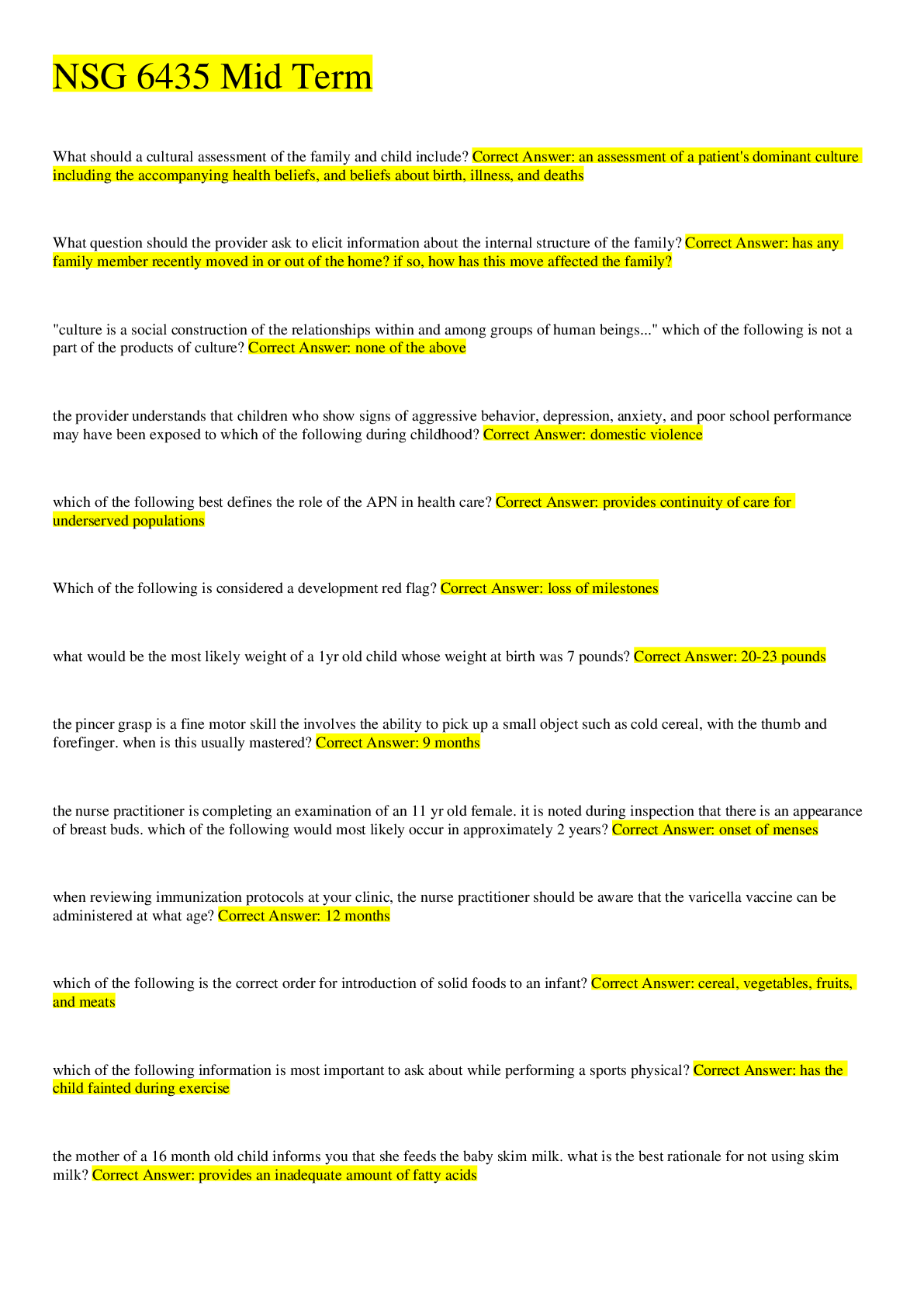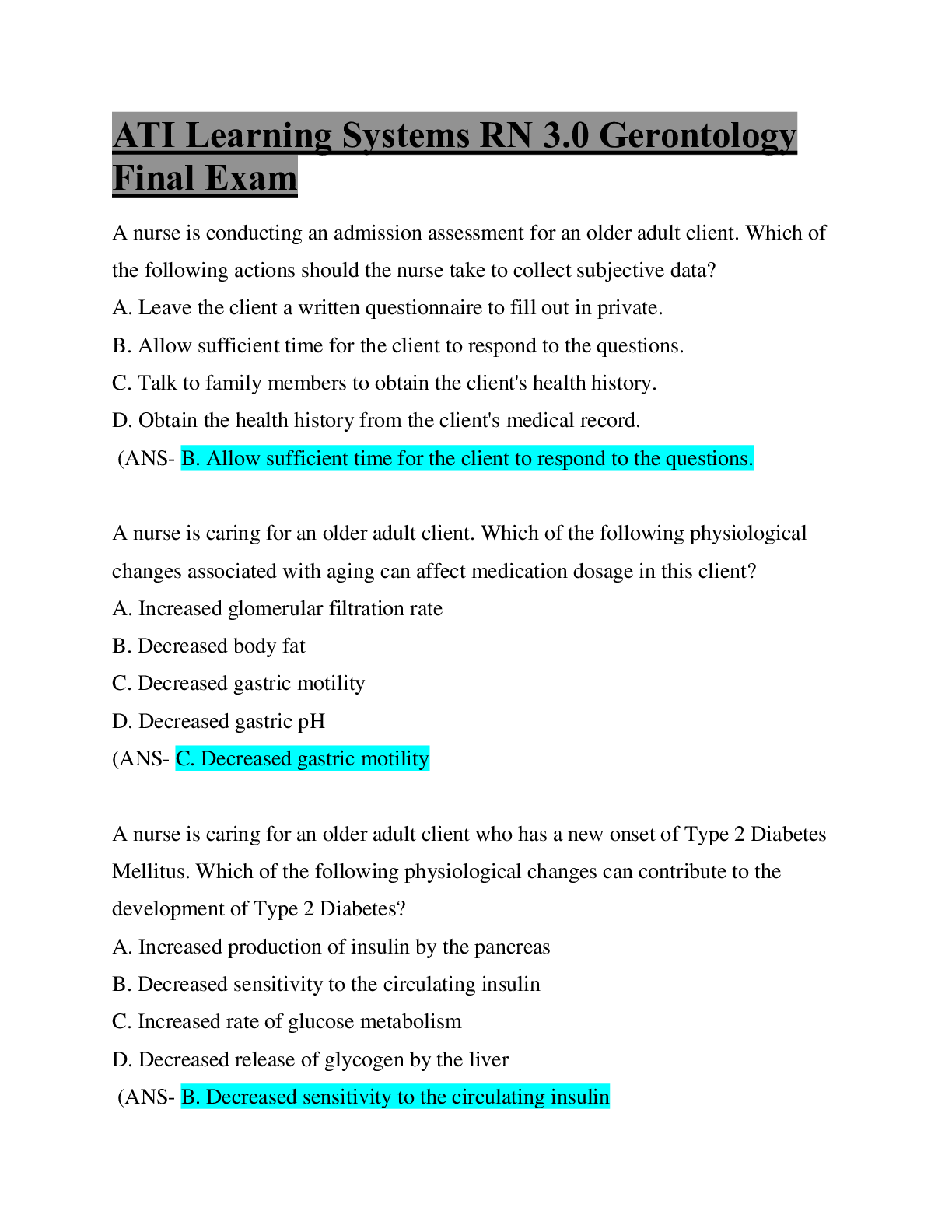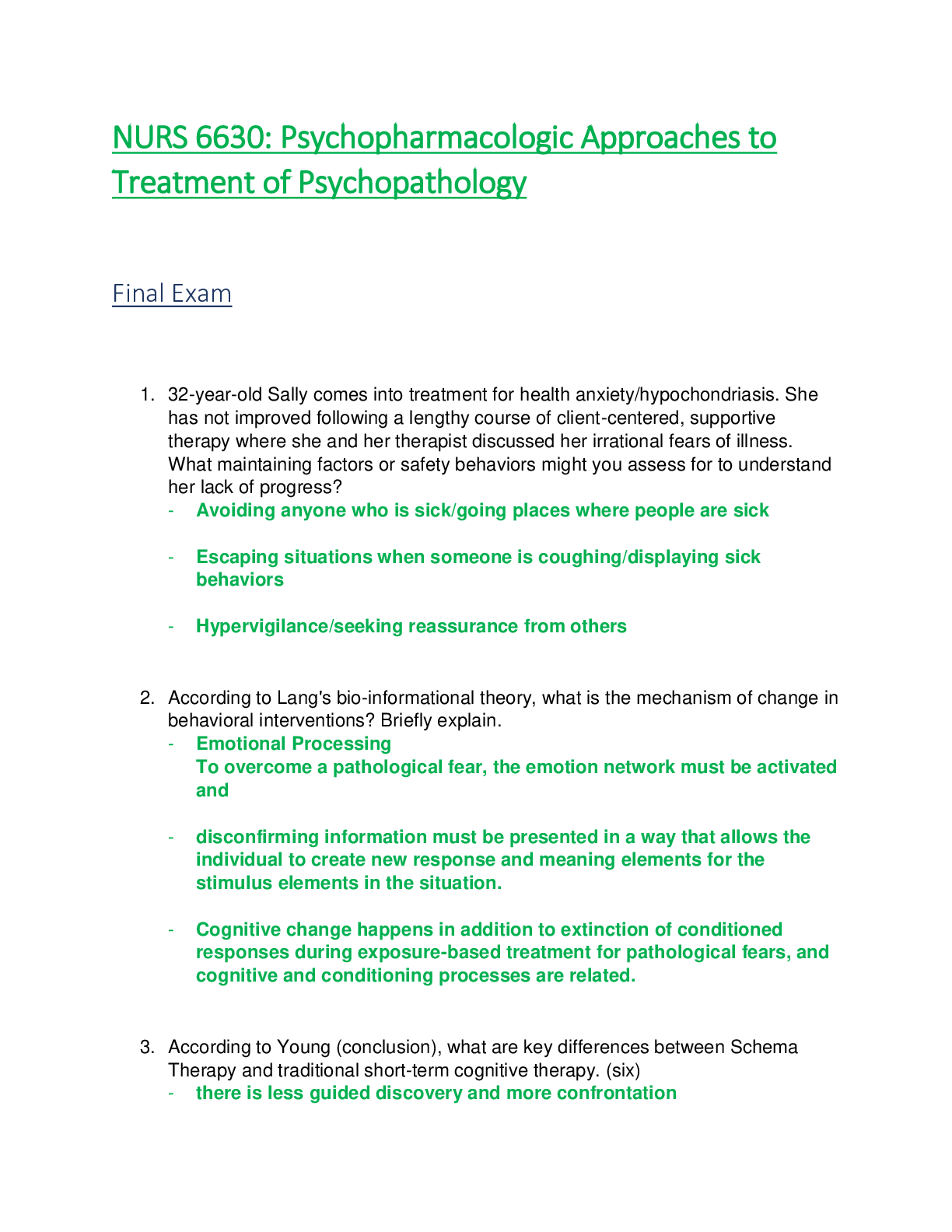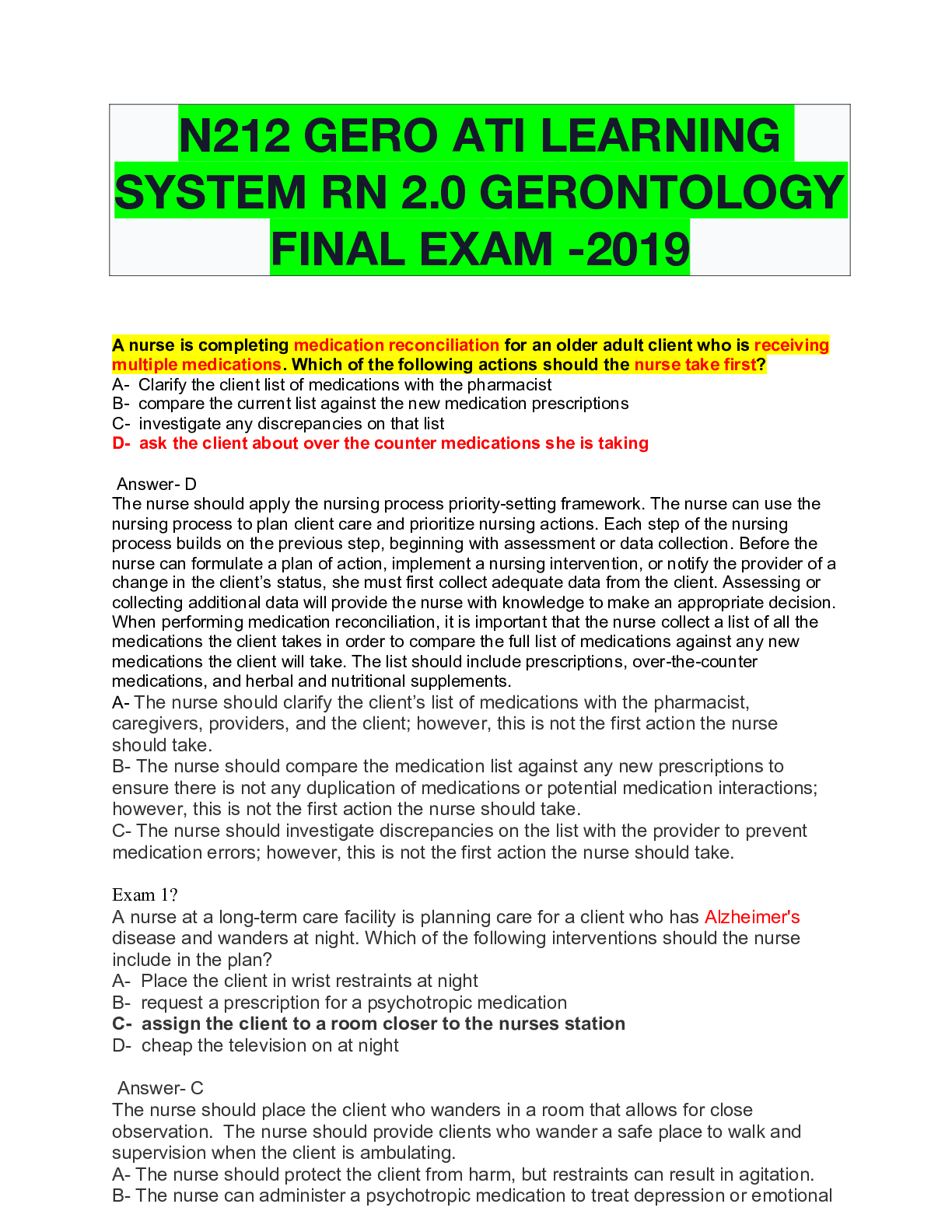*NURSING > EXAM > NSG6420 / NSG 6420: Practicum I Family Health - Adult and Gerontology Final Exam (Latest 2020 / 2021 (All)
NSG6420 / NSG 6420: Practicum I Family Health - Adult and Gerontology Final Exam (Latest 2020 / 2021)
Document Content and Description Below
Mini Mental Status: Buttaro Chapter 13 Geriatric specialists have multiple assessment tools, such as the Folstein Mini-Mental State Examination, the Mini-Cog screen for dementia, the Short Portable ... Mental Status Questionnaire, the AD8 Dementia Screening Interview, and the Montreal Cognitive Assessment (MoCa), to differentiate short-term memory loss from dementia and to observe the progression of cognitive impairment. Questions When prescribing medications to an 80-year-old patient, the provider will a. begin with higher doses and decrease according to the patient’s response. b. consult the Beers list to help identify potentially problematic drugs. c. ensure that the patient does not take more than five concurrent medications. d. review all patient medications at the annual health maintenance visit. The Beers list provides a list of potentially inappropriate medications in all patients age 65 and older and helps minimize drug-related problems in this age group. Older patients should be started on lower doses with gradual increase of doses depending on response and side effects. Patients who take five or more drugs are at increased risk for problems of polypharmacy, but many will need to take more than five drugs; providers must monitor their response more closely.Medications should be reviewed at all visits, not just annually. REF: Polypharmacy/Consequences of Polypharmacy/Management An 80-year-old woman who lives alone is noted to have a recent weight loss of 5 pounds. She appears somewhat confused, according to her daughter, who is concerned that she is developing dementia. The provider learns that the woman still drives, volunteers at the local hospital, and attends a book club with several friends once a month. What is the initial step in evaluating this patient? a. Obtain a CBC, serum electrolytes, BUN, and glucose b. Ordering a CBC, serum ferritin, and TIBC c. Referring the patient to a dietician for nutritional evaluation d. Referring the patient to a neurologist for evaluation for AD Patients with weight loss, confusion, and lethargy are often dehydrated and this should be evaluated by looking at Hgb and Hct, electrolytes, and BUN. This patient is currently leading an active life, so the likelihood that recent symptoms are related to AD, although this may be evaluated if dehydration is ruled out. Anemia would be a consideration when dehydration is ruled out. Referrals are not necessary unless initial evaluations suggest that malnutrition or AD is present. REF: Dehydration/Pathophysiology/Clinical Presentation/Physical ExaminationThe practitioner is establishing a plan for routine health maintenance for a new female client who is 80 years old. The client has never smoked and has been in good health. What will the practitioner include in routine care for this patient? Select all that apply. a. Annual hypertension screening b. Baseline abdominal aorta ultrasound c. Colonoscopy every 10 years d. One-time hepatitis B vaccine e. Pneumovax vaccine if not previously given f. Yearly influenza vaccine For older clients a one-time pneumovax is given after age 65. Influenza vaccine should be given every year. Hypertension screening should be performed at each office visit, not just annually. An abdominal aorta US is performed once for every smoking male. Colonoscopy is performed every 10 years after age 50, but not after age 74. REF: Table 13-1: Recommended Screening and Immunizations 2. HEENT Pharyngitis Buttaro Chapter 101 In noninfectious pharyngitis the patient reports a sore throat and dryness; if environmental allergens are the cause, symptoms often include rhinorrhea, watery eyes, and postnasal drip. Viral causes are more common (rhinorivus) In viral pharyngitis, findings include fever, cough, nasal symptoms, and mild erythema with little or no pharyngeal exudate. Treatment of viral pharyngitis includes rest, fluids, humidification, voice rest, and warm saline gargles to ease discomfort. 7 Acetaminophen or ibuprofen should be used for fever and general discomfort. Bacterial pharyngitis is more common in children younger than 15. Streptococcus pyogenes is the etiologic agent for acute pharyngitis. Group A β-hemolytic Streptococcus (GAS) is the most important to identify because it is responsible for acute rheumatic fever (ARF) and poststreptococcal glomerulonephritis. Patients may report a sudden onset of sore throat, painful swallowing, fever (temperature higher than 38.5° C [101.3° F]), chills, headache, nausea, vomiting, and abdominal pain. With bacterial pharyngitis, rhinitis, cough, conjunctivitis, and myalgias are not typically present. Diagnostic studies used to detect GAS infection include a throat culture, a rapid antigen detection test (RADT). Penicillin V, 500 mg 2-3 times daily for 10 days) is indicated in GAS pharyngitis primarily to prevent complications, such as suppurative tonsillitis, glomerulonephritis, and rheumatic fever. Clarithromycin, 250 mg twice daily for 10 days, is indicated for patients with penicillin allergy. questions A patient has sore throat, a temperature of 38.5° C, tonsillar exudates, and cervical lymphadenopathy. What will the provider do next to manage this patient’s symptoms?a. Order an antistreptolysin O titer b. Perform a rapid antigen detection test c. Prescribe empiric penicillin d. Refer to an otolaryngologist The RADT is performed initially to determine whether GAS is present. The ASO titer is not used during initial diagnostic screening. Penicillin should not be given empirically. A referral to a specialist is not required for GAS infection. A patient reports a sudden onset of sore throat, fever, malaise, and cough. The provider notes mild erythema of the pharynx and clear rhinorrhea without cervical lymphadenopathy. What is the most likely cause of these symptoms? a. Allergic pharyngitis b. Group A streptococcus c. Infectious mononucleosis d. Viral pharyngitis Viral pharyngitis will cause sore throat, fever, and malaise and is often accompanied by URI symptoms of cough and runny nose. Allergic pharyngitis usually also causes dryness. GAS causes high fever, cervical adenopathy, and marked erythema with exudate. Infectious mononucleosis will cause an exudate along with cervical adenopathy A school-age child has had 5 episodes of tonsillitis in the past year and 2 episodes the previous year. The child’s parent asks the provider if the child needs a tonsillectomy. What will the provider tell this parent? a. Current recommendations do not support tonsillectomy for this child. b. If there is one more episode in the next 6 months, a tonsillectomy is necessary. c. The child should have radiographic studies to evaluate the need for tonsillectomy. d. Tonsillectomy is recommended based on this child’s history. Recommendations suggest 6 to 7 documented episodes of GAS within 1 year, 5/year for 2 consecutive years, or 3/year for 3 years. Radiographic studies are not indicated Mononucleosis (Buttaro Chapter 233) EBV-IM (Epstein-Bar Virus infectious mononucleosis) occurs most often in adolescents and young adults, with the highest incident at ages 15 to 19. Transmission of EBV-IM occurs through exposure to oropharyngeal secretions. The classic triad of symptoms of acute IM includes fever, pharyngitis, and lymphadenopathy. The typical adolescent with EBV-IM is seen with sore throat, fever, and lymph node and tonsillar enlargement. Additional common presenting symptoms include pharyngeal inflammation and transient palatal petechiae. Reports indicate that splenic enlargement occurs in 40% to 100% of cases and can be confirmed with ultrasound. Anabdominal examination identifies splenomegaly and hepatomegaly. Rash and jaundice should be noted because they are associated with EBV-IM. he most useful laboratory test is the serologic test for heterophil antibodies. Treatment of uncomplicated EBV-IM is primarily supportive, including adequate hydration, nonsteroidal anti-inflammatory drugs or acetaminophen for fever reduction and myalgias. Individuals with splenomegaly should be encouraged to refrain from strenuous physical activity for 3 to 4 weeks to avoid the risk of splenic rupture Questions A patient with EBV-IM also has group A beta-hemolytic streptococcal pharyngitis and is being treated with amoxicillin. On the third day of treatment, the patient develops a rash. A urinalysis is normal. What does this indicate? a. A reaction to the amoxicillin b. A streptococcal rash c. Hematologic complications d. Hemolytic-uremic syndrome 80% to 100% of patients with IM who are taking amoxicillin will develop a rash. A streptococcal rash appears at the onset of symptoms, not 3 days after initiation of antibiotics. This rash does not indicate hematologic complications or hemolytic-uremic syndrome. An adolescent patient who plays football in high school is diagnosed with EBV infectious mononucleosis and is noted to have splenomegaly. What will the provider recommend to this patient about returning to sports? a. Abdominal ultrasounds are recommended to determine safety. b. Corticosteroid therapy may help shorten the course of the disease. c. He may return to minimal contact practice in 2 to 3 weeks. d. It will be safe to play football in 3 to 4 weeks. Patients with splenomegaly should be encouraged to refrain from strenuous activity for 3 to 4 weeks to avoid the risk of splenic rupture. Serial US studies beginning at week 2 to 3 may be helpful in determining the risk of rupture. Corticosteroids have not been shown to reduce the severity or duration of symptoms. Strenuous activity is not recommended until 3 to 4 weeks; without an US, it is not possible to ensure absolute safety for sports. An adolescent patient has fever, pharyngitis, and cervical lymphadenopathy and has a negative group A beta-hemolytic throat culture. A complete blood count shows absolute lymphocytosis, but a heterophil antibody test is negative for Epstein-Barr virus (EBV). What will the provider tell the patient about the likelihood of infectious mononucleosis (IM)? a. It will be necessary to repeat the heterophil antibody test in a few weeks. b. Liver function tests will help to confirm a diagnosis of EBV-IM.c. The likelihood of EBV infectious mononucleosis is still high. d. This IM is most likely caused by a virus other than Epstein-Barr virus. Because heterophil antibodies may not reach detectable levels early in the disease, it is possible to have a negative result. This patient has symptoms and the suspicion for disease remains high. Repeat testing in 7 to 10 days will help confirm the diagnosis. A positive heterophil antibody test with absolute lymphocytosis is diagnostic of acute IM. Epstein-Barr nuclear antigen is measured 6 to 8 weeks after onset of symptoms to distinguish between acute and previous infection. LFTs may be elevated in patients with IM, but this is not diagnostic. Symptoms associated with allergies (buttaro chapter 73) allergic conjunctivitis, a condition seen most frequently in the spring and summer. Unlike conjunctivitis from infectious causes, allergic conjunctivitis typically occurs simultaneously in both eyes. Its predominant feature is itching. If discharge is present, it will be clear or stringy and white. The conjunctiva has a boggy appearance. Because allergic conjunctivitis is typically associated with systemic allergies, an oral antihistamine can be helpful in controlling ocular symptoms. Agents to consider include fexofenadine and loratadine. Conjunctivitis Bacterial conjunctivitis is typically accompanied by thick, purulent discharge. Patients will report that both eyes are sticky or glued shut. Gonococcal conjunctivitis is typically seen in sexually active adults but can also occur in neonates via maternal-neonate transmission. trimethoprim–polymyxin B or fluoroquinolone drops, four times a day for 1 week. The following types of bacterial conjunctivitis require systemic treatment: • H. influenzae: treat with oral amoxicillin-clavulanate • Gonococcal: ceftriaxone, 1 g intramuscularly, one dose or ciprofloxacin, 500 mg orally if the patient has a penicillin allergy and one dose of azithromycin, 1g orally—requires same-day referral to an ophthalmologist. • Chlamydial: azithromycin, 1g orally, one dose or doxycycline, 100 mg twice daily for 7 days Viral conjunctivitis is self-limited and typically lasts 5 to 14 days. A recent upper respiratory infection or exposure to sick individuals can point to a diagnosis of adenoviral conjunctivitis. Treatment is supportive with artificial tears and cool compresses. In addition, topical corticosteroids should be avoided because they can prolong viral shedding and increase infectivity. Adenoviral conjunctivitis can occur in three different forms. Adenoviral conjunctivitis pharyngoconjunctival fever: systemic symptoms Epidemic keratoconjunctivitis: bilateral conjunctival hyperemia and chemosis, petechial and larger subconjunctival hemorrhages. have corneal involvement, and it is appropriate to refer these patients to an ophthalmologist. questions A patient who has a cold develops conjunctivitis. The provider notes erythema of one eye with profuse, watery discharge and enlarged anterior cervical lymph nodes, along with a fever. Which treatment is indicated?a. Antihistamine-vasoconstrictor drops b. Artificial tears and cool compresses c. Topical antibiotic eye drops d. Topical corticosteroid drops Viral conjunctivitis accompanies URI and is generally self-limited, lasting 5 to 14 days. Symptomatic treatment isrecommended. Antihistamine-vasoconstrictor drops are used for allergic conjunctivitis. Topical antibiotic drops are sometimes used for bacterial conjunctivitis. Topical corticosteroid drops are used for severe inflammation. A patient reports bilateral reports burning and itching eyes for several days. The provider notes a boggy appearance to the conjunctivae, along with clear, watery discharge. The patient’s eyelids are thickened and discolored. There are no other symptoms. Which type of conjunctivitis is most likely? a. Allergic b. Bacterial c. Chemical d. Viral Allergic conjunctivitis generally presents simultaneously in both eyes with itching as a predominant feature. Discharge is generally clear or stringy and white and the patient will have lid discoloration, thickening, and erythema. Bacterial conjunctivitis is characterized by acute inflammation of the conjunctivae along with purulent discharge. Chemical conjunctivitis will not have purulent discharge. Viral conjunctivitis is usually in association with a URI. A patient with allergic conjunctivitis who has been using a topical antihistamine-vasoconstrictor medication reports worsening symptoms. What is the provider’s next step in managing this patient’s symptoms? a. Consider prescribing a topical mast cell stabilizer b. Determine the duration of treatment with this medication c. Prescribe a non-sedating oral antihistamine d. Refer the patient to an ophthalmologist for further care Antibiotic-vasoconstrictor agents can have a rebound effect with worsening symptoms if used longer than 3 to 7 days, so the provider should determine whether this is the cause. Topical mast cell stabilizers are useful as prophylaxis for recurrent or persistent allergic conjunctivitis and results do not occur for several weeks. Oral antihistamines may be the next step if it is determined that the cause of worsening symptoms is related to the allergy. It is not necessary to refer to ophthalmology at this time. REF: Management Corneal abrasion (Buttaro chapter 74) The most common symptom of a corneal abrasion or foreign body is sudden onset of severe eye pain in the affected eye. This pain typically resolves after application of a topical anesthetic eye drop. Other symptoms include blurred vision, redness, tearing, light sensitivity, eyelidswelling, and blepharospasm. Use of topical fluorescein dye can assist in the diagnosis. One drop of fluorescein can be applied and viewed under a cobalt blue light or Wood lamp. A corneal abrasion should appear as a bright green area. Topical anesthetics such as proparacaine should never be used or prescribed for pain control; their prolonged use may lead to corneal melting. A healthy corneal epithelium will repopulate rapidly, from just a few hours for a small, uncomplicated defect to 3 to 5 days with larger defects. Questions A patient who works in a furniture manufacturing shop reports a sudden onset of severe eye pain while sanding a piece of wood and now has copious tearing, redness, and light sensitivity in the affected eye. On examination, the conjunctiva appears injected, but no foreign body is visualized. What is the practitioner’s next step? a. Administration of antibiotic eye drops b. Application of topical fluorescein dye c. Instillation of cyclopegic eye drops d. Irrigation of the eye with normal saline The practitioner must determine if there is a corneal abrasion and will instill fluorescein dye in order to examine the cornea under a Wood’s lamp. Antibiotic eye drops are not indicated as initial treatment. Cyclopegic drops are used occasionally for pain control, but should be usedwith caution. Irrigation of the eye is indicated for chemical burns. Glaucoma (Kennedy Chapter 7) Acute glaucoma, also known as angle-closure or narrow-angle glaucoma, is an obstruction to the outflow of aqueous humor from the posterior to the anterior chamber. The predominant age range is 60 to 70 years old. The history reveals severe, unilateral eye pain, blurred vision, lacrimation, reports of seeing colored halos around lights, and a red eye. Headache, nausea, and vomiting frequently accompany eye pain, causing eye pain to be overlooked. Immediately refer patients for a complete ophthalmic examination. permanent visual loss occurs within 2 to 5 days if this condition is untreated. Surgical treatment includes peripheral iridectomy or laser iridotomy Chronic Glaucoma: initially; tunnel vision, night blindness, halos around lights. gradual visual field loss, chronic glaucoma is called the silent blinder. Medical treatment with eye drops is usually first-line therapy Prostaglandin analogs are the most effective drugs at lowering IOP and can be considered as initial medical therapy. Ttimolol is frequently prescribed for glaucoma and can exacerbate bradycardia and asthma in susceptible patients. Questions During an eye examination, the provider notes a red light reflex in one eye but not the other. What is the significance of this finding? a. Normal physiologic variant b. Ocular disease requiring referral [Show More]
Last updated: 1 year ago
Preview 1 out of 55 pages
.png)
Reviews( 0 )
Document information
Connected school, study & course
About the document
Uploaded On
Jul 05, 2021
Number of pages
55
Written in
Additional information
This document has been written for:
Uploaded
Jul 05, 2021
Downloads
0
Views
23


.png)




